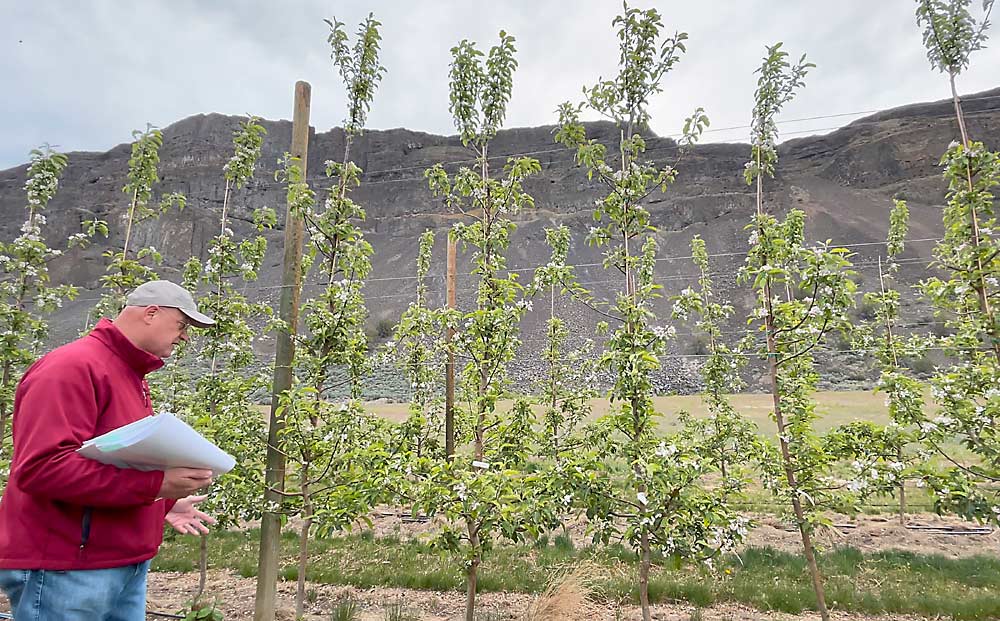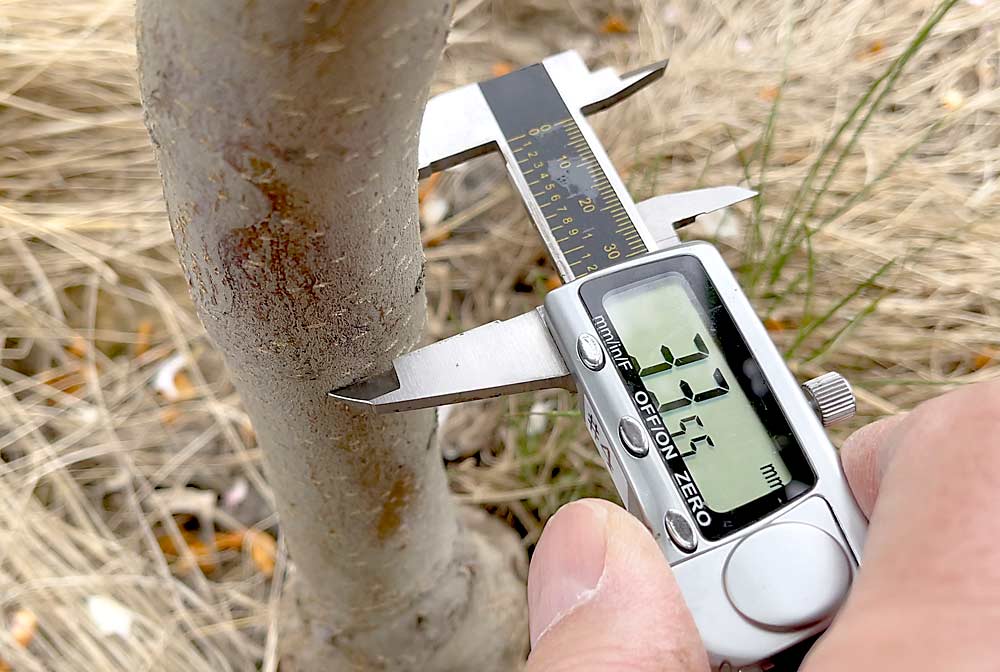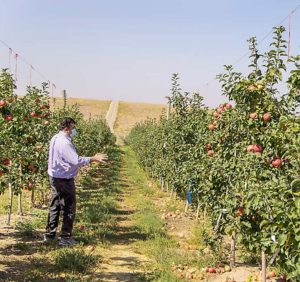
The hunt for the best dwarfing, precocious rootstocks for apple growers continues, and trials include some of the latest promising selections from breeding programs in New York and New Zealand.
At Washington State University’s Sunrise Research Orchard outside Wenatchee, Galas planted on 13 different rootstocks are now in their third leaf, which means “this will be the first year of a good crop” for evaluations, said Stefano Musacchi, the endowed chair of tree fruit physiology at WSU.
He planned the rootstock trial in conjunction with researchers at a dozen locations across the U.S. under the NC-140 Regional Research Project, which supports coordinated evaluation of rootstocks for tree fruit.
In 2019, the collaborators planted Buckeye Gala at 12-foot by 3-foot spacing on a mix of standard, promising and new rootstock selections, including: Budagovsky 10, Malling 26, M.9 T337, Geneva 11, G.41, G.214, G.935, G.969, two as yet unreleased selections from Cornell University and U.S Department of Agriculture’s Geneva breeding program and three unreleased, unnamed varieties from New Zealand.
The tall spindle system is managed with minimal early pruning, Musacchi said. After height measurements are taken this spring, the trees will all be headed back. Researchers also started collecting yield data in the second leaf. They use an index of precocity, comparing the yield in the first three years to the yield in the first five to understand which rootstocks enter into production earlier.

In 2020 data, yield ranged from about 2 pounds of fruit per tree in the second leaf for B.10 to over 5 pounds for M.9 and also for an unreleased selection from the Geneva program and one from the New Zealand program. But the 2021 and 2022 harvests will offer more valuable insight.
As for vigor, differences in tree height and trunk and branch diameter were already apparent. G.11 shows some of the lowest vigor, Musacchi said, while M.26 is the largest, most vigorous of the bunch.
G.41, which is becoming a standard in Washington thanks to its replant disease and fire blight tolerance, shows relatively low vigor in this trial, he said, while G.969 and G.214 land in the middle of the vigor range.
From the look of the bloom when Good Fruit Grower visited in late April, many of the trees appeared poised to produce a lot of fruit.
Musacchi stressed that the goal of the trial is not to find the best rootstock, but rather to continue to test new material to gauge potential benefits to growers.
“It would be nice to have this information before growers start to order trees,” he said. “If we do good work on rootstock evaluation, we can save a lot of money in the field.”
By replicating the same experimental design at each site and collecting the same data, the NC-140 group strives to give the industry confidence in comparing rootstock performance and how optimizing rootstock choice can enhance orchard management, Musacchi said.
But such work takes time and money.
“Each rootstock trial needs to run 10 years,” Musacchi said. That’s far longer than typical research grants. “There is no way to run a trial like that without support,” he said, which in this case comes from the endowment funds for his research program and a grant from the Northwest Nursery Improvement Institute.
—by Kate Prengaman
Want to learn more about the latest research on rootstocks, orchard systems and tree fruit physiology?
The International Society for Horticultural Science has rescheduled its XII International Symposium on Integrating Canopy, Rootstock and Environmental Physiology in Orchard Systems, now to be held July 26–30.
The organization had planned to hold a meeting in Wenatchee, Washington, last year but canceled it due to COVID-19. The meeting this year will instead be conducted online in a virtual format.
It’s a meeting by and for the research community, but others in the industry are welcome to tune in for the talks they find interesting, said organizer Stefano Musacchi, the endowed chair of tree fruit physiology at Washington State University.
Keynote speakers will include Lailiang Cheng, Cornell University; Luca Corelli Grappadelli, University of Bologna; Ted DeJong, University of California, Davis; Gennaro Fazio, Cornell; Lav Khot, WSU; Karen Lewis, WSU; Terence Robinson, Cornell; Stuart Tustin, New Zealand Institute for Plant and Food Research; and Maciej Zwieniecki, UC Davis. Almost 200 researchers applied to give presentations as part of the symposium, Musacchi said.
The schedule includes longer keynote talks, research presentations, quick “poster session” presentations and orchard tour videos. To accommodate presenters and attendees from around the globe, sessions will be recorded so they can be watched later, he said.
Interested growers and industry consultants can register at the student rate of $150, which includes access to the virtual meeting but not the book of scientific papers that comprises the conference proceedings. For more information and registration, visit https://2021orchardsystems.com.
—K. Prengaman







Leave A Comment